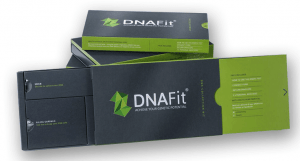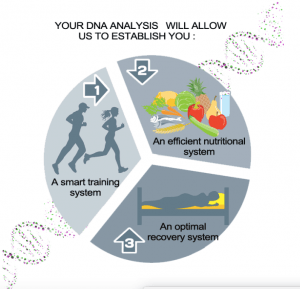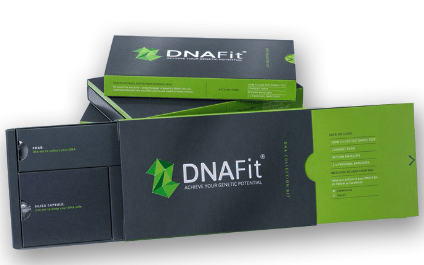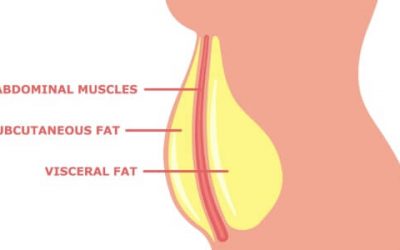DNA testing can tell you how to eat, train and achieve maximum health. At BodyScene we are always looking at different ways to motivate our clients to reach their training and nutrition goals.

The method used to analyse your DNA
Bodyscene will provide you with a kit which contains a cotton swab that is used to scrape off cells from your inside cheeks. This cotton swab is then placed inside the provided plastic tube and mailed back to the lab in the UK. The turnaround time for results is 10 business days. We will then email you a comprehensive report and a 3-month meal plan. Our nutritional therapist will sit with you and tell you everything you need to know about your fitness and nutrition related DNA.
All about genes
As you know, your body is composed of trillions of cells, providing structure to the body, converting nutrients obtained from food into energy and carrying out specialised functions.
Each cell has a nucleus which serves as the cell’s command center, directing the cell to grow, mature, divide or die. It also houses your DNA (deoxyribonucleic acid) which provides the blueprint for performing these functions. DNA contains four basic building blocks (called “bases”) – adenine (A), cystosine (C), guanine (G) and thymine (T). Similar to the way the order of letters in the alphabet can be used to form a word, the order of bases in a DNA sequence forms genes. Genes are the language that tells the cell how to make proteins. Humans have over 20,000 different kinds of genes.

Mutations
The whole human family is one species with the same genes. Whenever cells divide, a new copy of the DNA is created. Mutations are “typos” in the new DNA and occur quite frequently. They manifest as a substitution of one base for another. Usually these mutations are corrected by the cell, but some mutations persist and are passed along to offspring. So you have gene variations passed along to you by both of your parents. Another name of the gene variations is “allele”. These small differences in DNA sequence make every individual unique. They account for the variation we see in human hair color, skin color, height, shape, behavior, and susceptibility to disease. Individuals in other species vary too, in both physical appearance and behavior. Through gene testing, an individual’s specific mutations can be identified.
For instance, the CYP1A2 gene, it regulates a cell’s ability to produce the CYP1A2 enzyme which affects the liver’s ability to metabolize caffeine. Another gene, AHR, also plays a role in that it regulates the turning on and off of the CYP1A2 gene. 10% of the population are rapid caffeine metabolizers and thus not very caffeine sensitive.
Or the FTO gene (so called the ‘obesity gene’) that triggers weigh gain. One in six of the population are 70 per cent more likely to become obese, if the AA version of this gene is present.
Hundreds of studies have been done to determine correlations between genes and human attributes. The researchers at DNAFit have narrowed these down to studies that show how genetics impact an individual’s diet and fitness.
At Bodyscene, we offer the most comprehensive DNA test, which is the Diet/Fitness combination report. Here are the specific items included in the report:
- Power/Endurance profile – reveal your body’s response to key genes associated power or endurance potential. Understand how best to
- train for your body, whatever your goal may be.
- Aerobic Potential – VO2 max is the most commonly used marker for endurance potential, we can help you understand your genetic VO2 max potential.
- Recovery Speed – everybody has a different recovery ability – understand what your genes say about your natural recovery speed, and how to plan your exercise regime accordingly.
- Recovery Needs – get to know your body’s genetic need for certain vitamins and micronutrients. Learn how this can help you manage your recovery strategy after hard exercise.
- Injury Risk – some people are more genetically prone to injury than others, we help you identify where your genes put you on the injury risk scale.
- Optimal Diet Type – choosing the right diet can be a confusing process. Using our individual response to both carbohydrates and fats, our genes can help guide us to the best routine for weight management.
- Carbohydrate Sensitivity – your individual genetic response to carbohydrate. Our genetics play a role in how careful we need to be with our refined carbohydrate intake to stay healthy and in shape.
- Saturated Fat Sensitivity – your individual genetic response to saturated fats. Despite getting a bad press in recent years, fat is actually essential for human healthy. How much we should consume is affected by our genetics.
- Detoxification Ability – how efficient is your detoxification pathway? Our genes play a role in how much high temperate cooked meals we can eat and if we need more cruciferous vegetables to aid liver function.
- Anti-Oxidant Need – anti-oxidants are found in fresh foods such as vegetables and fruits; our genetics play an important role in how much of these antioxidant rich foods we need.
- Omega-3 Need – omega-3 fatty acids are a type of unsaturated fat that our bodies need to function normally. Our genes guide us as to how much Omega 3 we need to aim for in our diet.
- Vitamin B Requirements – our nervous system, digestion and red blood cells depend on the B vitamins to maintain normal function. Some of us require more than others of these essential vitamins for a healthy lifestyle.
- Vitamin D Requirements – vitamin D helps us maintain normal calcium levels and strengthens our bone structure. The Vitamin D Receptor gene helps us understand how much of this important vitamin we need to aim for.
- Salt Sensitivity – excess salt intake has been linked to increased rick of hypertension, and some of us have certain genes which mean we need to be extra careful of our salt intake.
- Alcohol Response – is a glass of wine a day really good for you? In some genotypes, moderate alcohol consumption can actually create a positive effect on cholesterol, find out which one you are!
- Caffeine Sensitivity – our genes help metabolise caffeine. Some genotypes are fast metabolisers, and some slow. Our individual genetics help us choose how much caffeine we should intake on a daily basis.
- Lactose Intolerance – do you possess the gene which helps your body digest milk? The version of the LCT gene we hold allows us to know whether we need to avoid drinking lactose.
- Coeliac Predisposition – our genetics impact whether our risk of being Coeliac. Find out whether you are at an average, raised or lowered predisposition. This is not a diagnostic test.
- Overall Nutrient Guidelines – take an overall summary look at the different micronutrient, vitamins and minerals that our genes affect. Find out whether the average recommendation or a raised need applies for you.
Olympian Benchmark
Compare your results to one of three Olympic athletes – Greg Rutherford, Craig Pickering or Andrew Steele to get a good idea of how you might compare genetically to some world-class athletes.
The Results
The reports are provided as 9 downloadable PDF infographics. You also get a 12-week meal plan with recipes, and one hour with our Nutritionist to understand your results (this service is provided for an additional fee).
We will admit that the information can be bit overwhelming, but with a clear explanation you’ll soon realise that your own DNA testing will provide a solid blueprint to helping you make the best exercise and food choices.



